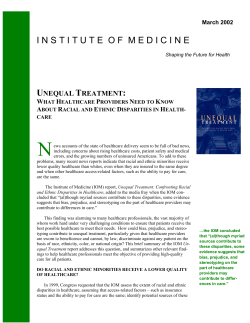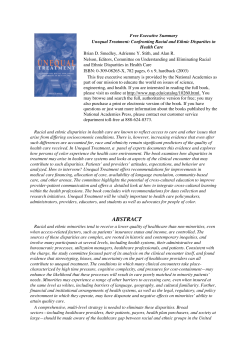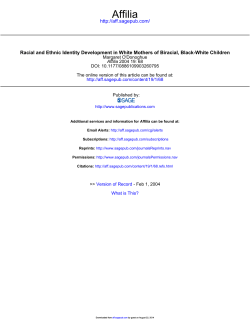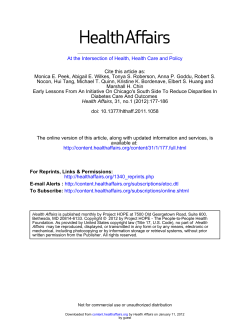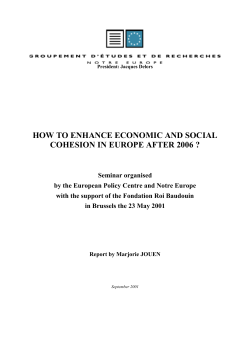
I I N S T I T U T E ... U T
March 2002 INSTITUTE OF MEDICINE Shaping the Future for Health UNEQUAL TREATMENT: WHAT HEALTH CARE SYSTEM ADMINISTRATORS NEED TO KNOW ABOUT RACIAL AND ETHNIC DISPARITIES IN HEALTHCARE I f you are a health system administrator or manager, yours may be among the most difficult jobs in the nation: on a daily basis, you contend with multiple challenges, including rapidly escalating health care costs, concerns about patient safety, and negative public perceptions of health insurers. At the same time, you work hard to provide high-quality health care products and services to an increasingly diverse patient population—including a growing number of racial and ethnic minorities and individuals who primarily speak a language other than English. To compound these concerns, minorities and non-English speakers have greater difficulty accessing needed health care services. Minorities are disproportionately more likely than the general population to be uninsured, and are overrepresented among those in publicly-funded health systems (e.g., Medicaid, see Figure 1). Even when these individuals have the same health insurance and similar access to a health care provider as non-minorities, recent research indicates that racial and ethnic minorities tend to receive a lower quality of healthcare than whites. How can these disparities exist, when health systems and health care professionals have dedicated themselves and work hard to provide the highest possible quality of care to all patients? The Institute of Medicine (IOM) addressed this and other questions regarding disparities in the quality of care for different racial and ethnic groups in a report, Unequal Treatment: Confronting Racial and Ethnic Disparities in Healthcare. This report concluded that “[t]he sources of these disparities are complex, are rooted in historic and contemporary inequities, and involve many participants at several levels, including health systems, their administrative and bureaucratic processes, utilization managers, health care professionals, and patients.” In other words, many actors may contribute—wittingly or unwittingly, in ways both large and small—to create a pattern of inequitable care. This brief summary of the IOM Unequal Treatment report describes how these disparities may emerge, and summarizes relevant findings and recommendations to help healthcare managers and professionals meet the objective of providing high-quality care for all patients. How can these disparities exist, when health systems and health care professionals have dedicated themselves and work hard to provide the highest possible quality of care to all patients? Figure 1. Sources of health insurance for population under age 65, by race and ethnicity, 1999. NOTE: Numbers may not add to 100 percent due to respondents reporting more than one source of coverage and due to rounding. SOURCE: Fronstin, 2000 WHAT IS THE EVIDENCE REGARDING HEALTH CARE DISPARITIES? In 1999, Congress requested that the IOM: 1) assess the extent of racial and ethnic disparities in healthcare, assuming that access-related factors such as insurance status and the ability to pay for care are the same; 2) identify potential sources of these disparities; and 3) suggest intervention strategies. To fulfill this request, an IOM study committee reviewed well over 100 studies that assessed the quality of healthcare for various racial and ethnic minority groups, while holding constant variations in insurance status, patient income, and other access-related factors. Many of these studies also controlled for other potential confounding factors, such as racial differences in the severity or stage of disease progression, the presence of co-morbid illnesses, where care is received (e.g., public or private hospitals and health systems) and other patient demographic variables, such as age and gender. Some studies that employed more rigorous research designs followed patients prospectively, using clinical data abstracted from patients’ charts, rather than administrative data used for insurance claims. …research indicates that minorities are less likely than whites to receive needed services, including clinically necessary procedures, even after correcting for access-related factors, such as insurance status. The study committee was struck by what it found. Even among the better-controlled studies, the vast majority of published research indicates that minorities are less likely than whites to receive needed services, including clinically necessary procedures, even after correcting for access-related factors, such as insurance status. In general, this research shows that: African Americans and Hispanics tend to receive a lower quality of healthcare across a range of disease areas (including cancer, cardiovascular disease, HIV/AIDS, diabetes, mental health, and other chronic and infectious diseases) and clinical services; African Americans are more likely than whites to receive less desirable services, such as amputation of all or part of a limb; Disparities are found even when clinical factors, such as stage of disease presentation, co-morbidities, age, and severity of disease are taken into account; Disparities are found across a range of clinical settings, including public and private hospitals, teaching and non-teaching hospitals, etc.; and 2 Disparities in care are associated with higher mortality among minorities who do not receive the same services as whites (e.g., surgical treatment for small-cell lung cancer). WHAT ARE POTENTIAL SOURCES OF RACIAL AND ETHNIC DISPARITIES IN HEALTHCARE? …many sources may contribute to racial and ethnic disparities in care… The IOM report notes that many sources—including those related to characteristics of patients, of health systems, and the clinical encounter—may contribute to racial and ethnic disparities in care: Minority Patients and Health Care Disparities Some researchers speculate that minority patients may receive a lower quality of healthcare as a result of differences in health care seeking behaviors. Minority patients, for example, may be more likely than whites to refuse recommended services and delay seeking healthcare. These behaviors and attitudes can develop as a result of a poor cultural match between minority patients and their providers, mistrust, misunderstanding of provider instructions, poor prior interactions with health care systems, inadequate access to private physician offices and clinics, or simply from a lack of knowledge of how to best use health care services. Racial and ethnic differences in patient preferences and care-seeking behaviors and attitudes, however, are unlikely to be major sources of health care disparities. For example, while minority patients have been found to refuse recommended treatment more often than whites, differences in refusal rates are small and have not fully accounted for racial and ethnic disparities in the utilization of health care services. In addition, it remains unclear why these patients are more likely to reject treatment recommendations. Are they refusing treatment because of a general mistrust of health care providers? Or do some decline treatment because of negative experiences in the clinical encounter or a perception that their doctor is not invested in their care? More research is needed to fully understand treatment refusal because the reasons for refusal may lead to different strategies to help patients make informed treatment decisions. The Clinical Encounter and Health Care Disparities To understand how aspects of the clinical encounter may contribute to health care disparities, it’s important to understand how doctors make decisions about patient care. Many of the decisions that doctors must make are made with a degree of uncertainty. This uncertainty may be related to the patient’s diagnosis, how the patient may respond to treatment, whether treatment might lead to potential complications, or even the patient’s long-term outlook. To make matters worse, in many health care settings doctors may face significant time pressures, resource constraints, and on occasion, complex medical problems that are not easily understood or solved. Uncertainty can therefore make finding the right diagnosis and treatment plan a challenge for any doctor. But when faced with patients who are from different racial or ethnic backgrounds, doctors may find that their uncertainty about the patient’s condition and best course of treatment is even greater. This uncertainty can “open the door” for physicians’ stereotypes and biases to affect their judgment of patients and interpretation of their presenting concerns. 3 A large body of research in social psychology has demonstrated that stereotyping is an almost universal human cognitive function. A large body of research in social psychology has demonstrated that stereotyping is an almost universal human cognitive function. Stereotyping is a process by which people use social groups (such as sex and race) to gather, process, and recall information about other people. Stereotyping helps people to organize a very complex world, and can give us more confidence in our abilities to understand a situation and respond to it, particularly when we lack information. There is, however, a downside to stereotyping, in that it is the nature of stereotypes to be biased or unfair. Over four decades of research in cognitive and social psychology reveals that stereotypes: Are automatically activated (that is, they are generated without conscious effort); Are held even by people who truly believe that they do not judge others based on social categories, but have been unconsciously influenced by the implicitly biased stereotypes in American society; Affect how we process and recall information about others (people are more likely to recall information about others that is consistent with widely-held social stereotypes about minorities, women, etc.); and, Guide our expectations and perceptions and shape our personal interactions, producing “self-fulfilling prophecies” (that is, our own beliefs about how a situation should or will unfold can actually influence the interaction so that it meets our expectations). … research to date has demonstrated that health care providers’ diagnostic and treatment decisions, as well as their feelings about patients, are influenced by patients’ race or ethnicity and stereotypes associated with them. While more research must be done to better understand how stereotypes and biases affect the clinical encounter, research to date has demonstrated that health care providers’ diagnostic and treatment decisions, as well as their feelings about patients, are influenced by patients’ race or ethnicity and stereotypes associated with them. A study of cardiologists, for example, found that these physicians referred white male, black male, and white female hypothetical “patients” (actually videotaped actors who displayed the same symptoms of cardiac disease) for cardiac catheterization at the same rates (approximately 90 percent for each group), but were significantly less likely to recommend catheterization procedures for black female patients exhibiting the same symptoms. Another experiment found that when mental health professionals were briefly shown African American stereotype-laden words (for example, “basketball,” “lazy,” and “jazz”) before reading a description of a hypothetical patient, they evaluated the patient (whose race was not identified) more negatively than when they were shown neutral words prior to reading the patient description. In a study based on actual clinical encounters, researchers found that doctors rated black patients as less intelligent, less educated, more likely to abuse drugs and alcohol, more likely to fail to comply with medical advice, more likely to lack social support, and less likely to participate in cardiac rehabilitation than white patients, even after patients’ income, education, and personality characteristics were taken into account. HEALTH SYSTEMS ATTRIBUTES AND HEALTH CARE DISPARITIES Aspects of health systems—such as the ways in which systems are organized and financed, and the availability of services—may exert different effects on patient care, particularly for racial and ethnic minorities. Language barriers, for example, pose a problem for many patients where health systems lack the resources, knowledge, or institutional priority to provide interpretation and translation services. Nearly 14 million Americans 4 are not proficient in English (see Figure 2), and as many as one in five Spanish-speaking Latinos reports not seeking medical care due to language barriers. Similarly, time pressures on physicians may hamper their ability to accurately assess presenting symptoms of minority patients, especially where cultural or linguistic barriers are present. Further, the geographic availability of health care institutions—while largely influenced by economic factors—may have a differential impact on racial and ethnic minorities, independently of insurance status. A study of the availability of opioid supplies, for example, revealed that only one in four pharmacies located in predominantly non-white neighborhoods carried adequate supplies, compared to 72 percent of pharmacies in predominantly white neighborhoods. Changes in the financing and delivery of health care services—such as the shifts brought by cost-control efforts and the movement to managed care—may also pose greater barriers to care for racial and ethnic minorities than for non-minorities. Increasing efforts by states to enroll Medicaid patients in managed care systems, for example, may disrupt traditional community-based care and displace providers who are familiar with the language, culture, and values of ethnic minority communities. For example, a recent study indicates that minorities enrolled in publicly-funded managed care plans are less likely to access services after mandatory enrollment in an HMO, compared to whites enrolled in the same health systems and other minorities enrolled in Medicaid non-managed care plans. Some disparities may also emerge from the fact that health systems are becoming increasingly fragmented based on resource constraints. Fragmentation occurs when patients—even those enrolled in private health plans—receive different types and qualities of treatment as a result of dif- ferent levels of plan coverage, differing benefit packages and different degrees of provider choice. Individuals in lower tier health plans commonly face higher per-patient resource con- straints and have fewer choices with regard to health products and services, which may result in a poorer quality of care. To the extent that racial and ethnic minorities are more likely, for eco- nomic reasons, to enroll in lower tiered plans, fragmentation may contribute to disparities in healthcare. Nearly 14 million Americans are not proficient in English, and as many as one in five Spanishspeaking Latinos reports not seeking medical care due to language barriers. Figure 2. Percentage Linguistically Isolated Households, by Race and Ethnicity, United States, 1990. SOURCE: U.S. Bureau of the Census, 1993. WHAT CAN BE DONE TO ELIMINATE RACIAL AND ETHNIC DISPARITIES IN HEALTHCARE? The IOM Unequal Treatment report argues for a comprehensive, multi-level strategy to eliminate health care disparities, addressing health care systems, the legal and regulatory contexts in which they operate, health care providers, and their patients. Raising Public and Health Care Professionals’ Awareness of the Problem. The report’s authors conclude that a significant barrier to eliminating health care disparities is a lack of awareness of the problem on the part of key stakeholders. Therefore, an impor- 5 …an important first step is to raise awareness of the health care gap among broad sectors, including health care providers, their patients, payors, health plan purchasers, and society at large. tant first step is to raise awareness of the health care gap among broad sectors, including health care providers, their patients, payors, health plan purchasers, and society at large. Health Systems Interventions. Health systems can take several steps to equalize and promote high quality care for all patients: Base decisions about resource allocation (e.g., which patients should receive particular treatments for specific health conditions) on published clinical guidelines; Take steps to improve access to care—including the provision of interpretation and translation services, where community need exists; To the extent possible, equalize access to the same health care products and services, to avoid fragmentation of health plans; Insure that physician financial incentives do not disproportionately burden or restrict minority patients’ access to care; Support the use of community health workers and multidisciplinary treatment and preventive care teams; and Collect and monitor data on patients’ access and utilization of health care services by race, ethnicity, and primary language. Legal, Policy, and Regulatory Strategies. The IOM report calls for several steps to be taken by state and federal health policymakers: State programs that mandate the enrollment of Medicaid beneficiaries in managed care plans should pay plans at rates that give enrollees access to the same health plan products serving substantial proportions of privately-insured patients; Publicly-funded health systems should take steps to improve the stability of patient-provider relationships by establishing guidelines for minimum patient caseloads, allowing time flexibility in clinical encounters, and enhancing the stability of patients’ assignments to primary care providers; Federal, state, and private stakeholders should continue efforts to substantially increase the proportion of underrepresented U.S. racial and ethnic minorities among health professionals, to improve access to care among minority patients and to reduce cultural and linguistic barriers to care; and, The U.S. Department of Health and Human Services should encourage collection, reporting, and monitoring of patient care by health plans and federal and state payors as a means to assess progress in eliminating disparities, to evaluate intervention efforts, and to assess potential civil rights violations. Educational Strategies. Both patients and providers can benefit from education. Patients can benefit from culturally appropriate education programs to improve their knowledge of how to access care and their ability to participate in clinical-decision making. More importantly, health care professionals need tools to understand and manage the cultural and linguistic diversity of patients seen in today’s health systems and avoid allowing unconscious biases and stereotypes to affect their interactions with patients. Crosscultural curricula should be integrated early into the training of future health care providers, and practical, case-based, rigorously evaluated training should persist through practitioner continuing education programs. 6 CONCLUSION Racial and ethnic disparities in healthcare persist despite considerable progress in expanding health care services and improving the quality of patient care. Many factors contribute to these disparities in complex ways, but the quality of healthcare can be improved for all patients with a comprehensive strategy that includes attending to the needs of health care providers and their patients, to the conditions of health care settings in which care takes place, to the broader policies and practices of health systems, and to state and federal policies that govern the operation of health systems. These strategies are likely not only to reduce health care disparities, but also to improve the efficiency and equity of care for all patients. E E E For More Information… Copies of Unequal Treatment: Understanding Racial and Ethnic Disparities in Health Care are available for sale from the National Academy Press; call (800) 624-6242 or (202) 3343313 (in the Washington metropolitan area), or visit the NAP home page at www.nap.edu. The full text of this report is available at http://www.nap.edu/catalog/10260.html Support for this project was provided by the U.S. DHHS Office of Minority Health, with additional support for report dissemination provided by the California Endowment and The National Academies. The views presented in this report are those of the Institute of Medicine Committee on Understanding and Eliminating Racial and Ethnic Disparities in Health Care and are not necessarily those of the funding agencies. The Institute of Medicine is a private, nonprofit organization that provides health policy advice under a congressional charter granted to the National Academy of Sciences. For more information about the Institute of Medicine, visit the IOM home page at www.iom.edu. Copyright ©2003 by the National Academy of Sciences. All rights reserved. Permission is granted to reproduce this document in its entirety, with no additions or alterations E E E COMMITTEE ON UNDERSTANDING AND ELIMINATING RACIAL AND ETHNIC DISPARITIES IN HEALTH CARE ALAN R. NELSON, M.D., (Chair), retired physician and current Special Advisor to the Chief Executive Officer, American College of Physicians–American Society of Internal Medicine, Washington, DC; MARTHA N. HILL, Ph.D., R.N., (Co-Vice Chair), Interim Dean, Professor and Director, Center for Nursing Research, Johns Hopkins University School of Nursing, Baltimore, MD; RISA LAVIZZO-MOUREY, M.D., M.B.A., (CoVice Chair), Senior Vice President, Health Care Group, Robert Wood Johnson Foundation, Princeton, NJ; JOSEPH R. BETANCOURT, M.D., M.P.H., Senior Scientist, Institute for Health Policy, Director for Multicultural Education, Multicultural Affairs Of- 7 …the quality of healthcare can be improved for all patients with a comprehensive strategy… not only to reduce health care disparities, but also to improve the efficiency and equity of care for all patients. fice, Massachusetts General Hospital, Partners HealthCare System, Boston, MA; M. GREGG BLOCHE, J.D., M.D., Professor of Law, Georgetown University and Co- Director, Georgetown-Johns Hopkins Joint Program in Law and Public Health, Washing- ton, DC; W. MICHAEL BYRD, M.D., M.P.H., Instructor and Senior Research Scien- tist, Harvard School of Public Health, and Instructor/Staff Physician, Beth Israel Deacon- ess Hospital, Boston, MA; JOHN F. DOVIDIO, Ph.D., Charles A. Dana Professor of Psychology and Interim Provost and Dean of Faculty, Colgate University, Hamilton, NY; JOSE ESCARCE, M.D., Ph.D., Senior Natural Scientist, RAND and Adjunct Professor, UCLA School of Public Health, Los Angeles, CA; SANDRA ADAMSON FRYHOFER, M.D., MACP, practicing internist and Clinical Associate Professor of Medi- cine, Emory University School of Medicine, Atlanta, GA; THOMAS INUI, Sc.M., M.D., Senior Scholar, Fetzer Institute, Kalamazoo and Petersdorf Scholar-in-Residence, Association of American Medical Colleges, Washington, DC.; JENNIE R. JOE, Ph.D., M.P.H., Professor of Family and Community Medicine, and Director of the Native American Research and Training Center, University of Arizona, Tucson, AZ; THOMAS McGUIRE, Ph.D., Professor of Health Economics, Department of Health Care Policy, Harvard Medical School, Boston, MA; CAROLINA REYES, M.D., Vice President, Planning and Evaluation, The California Endowment, Woodland Hills, CA; DONALD STEINWACHS, Ph.D., Chair and Professor of the Department of Health Policy and Management, Johns Hopkins School of Hygiene and Public health, and Director, Johns Hopkins University Health Services Research and Development Center, Baltimore, MD; DAVID R. WILLIAMS, Ph.D., M.P.H., Professor of Sociology and Research Scientist, Institute for Social Research, University of Michigan, Ann Arbor, MI Health Sciences Policy Board Liaison GLORIA E. SARTO, M.D., Ph.D., Professor, University of Wisconsin Health, Depart- ment of Obstetrics and Gynecology, Madison, WI IOM Project Staff BRIAN D. SMEDLEY, Study Director; ADRIENNE Y. STITH, Program Officer DANIEL J. WOOTEN, Scholar-in-Residence; THELMA L. COX, Senior Project As- sistant; SYLVIA I. SALAZAR, Edward Roybal Public Health Fellow, Congressional Hispanic Caucus Institute 8
© Copyright 2024
